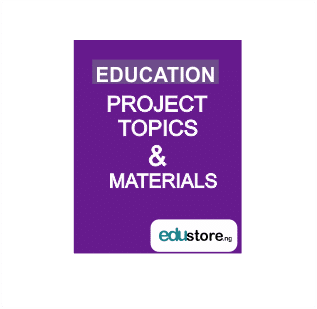ABSTRACT
The aim of this study is to trace the history and development of Lagooz College, Orile Agege, Lagos State from 2005 to 2011, in order to justify its existence since its establishment in 2005. This project also reveals their short comings and thereby make recommendations where necessary for future development. The study is divided into five chapters. In chapter one of this study, the researcher discussed into details, the geographical and historical background of the town, where the school is located, statement of the problems, purpose and significance of the study, scope and limitation of the study and definitions of terms and abbreviations used by the researcher. The second chapter contains the review of related literature having direct bearing with this project topic. Chapter three is the method used in collecting data. The fourth chapter highlights the results and analysis of the information collected. The researcher’s attention focus on Administrative control, student population, student admission policy, curriculum, examination and periodical tests, finance, social and intellectual development, rules and regulations e.t.c. Chapter five which is the concluding part deals with conclusion, suggestion for further study and recommendation.
TABLE OF CONTENTS
Title page i
Certification ii
Dedication iii
Acknowledgements iv
Table of Contents vi
List of Tables ix
Abstract x
CHAPTER ONE: INTRODUCTION
Background to the Study 1
Statement of the Problem 9
Purpose of Study 10
Research Question 12
Scope of the Study 12
Operational Definition of Terms 13
Significance of the Study 14
CHAPTER TWO: REVIEW OF RELATED LITERATURE
Concept of School Environment 17
Types of School Environment 25
Comparison of Academic Performance of Schools in Urban and Rural School Environment 31
Concept of Academic Performance 34
Relationship between Individual Differences and Academic Achievement 35 Relationship between School Environment and Academic Achievement 37 Appraisal of Literature Reviewed 39
CHAPTER THREE: RESEARCH METHODOLOGY
Research Type 40
Population, Sample and Sampling Techniques 41
Instrumentation 44 Procedure for Data Collection 45
Data Analysis Technique 46
CHAPTER FOUR: DATA ANALYSIS AND RESULTS
Data analysis, Presentation and Results 47
CHAPTER FIVE: DISCUSSION CONCLUSION AND RECOMMENDATIONS Discussion 59
Conclusion 61
Recommendations 62
Suggestion for Further Research 64
References 65
Appendix 68
DOWNLOAD COMPLETE WORK- For Reference Only: Materials are for research, citation, and idea generation purposes and not for submission as your original final year project work.
- Avoid Plagiarism: Do not copy or submit this content as your own project. Doing so may result in academic consequences.
- Use as a Framework: This complete project research material should guide the development of your own final year project work.
- Academic Access: This platform is designed to reduce the stress of visiting school libraries by providing easy access to research materials.
- Institutional Support: Tertiary institutions encourage the review of previous academic works such as journals and theses.
- Open Education: The site is maintained through paid subscriptions to continue offering open access educational resources.





